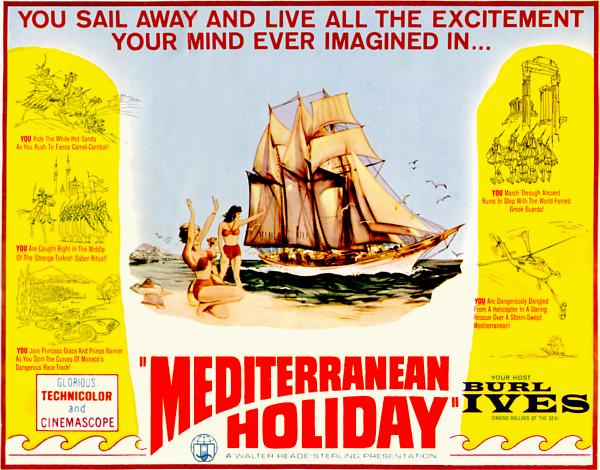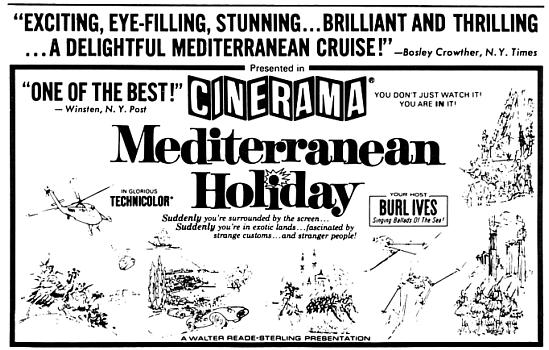Despite being the undisputed king of all the widescreen systems, Cinerama had a hard time making money for its owners. To make matters worse, after the abandonment of three-strip and the construction or conversion of hundreds of Super Cinerama theatres, there was always a problem of providing enough product for the theatres, especially in cities that boasted two or three Cinerama houses. The shortage of titles had first been felt in the late 1950s, resulting in Cinerama acquiring Cinemiracle and 45 prints of Windjammer along with its negative. Part of that deal was a three-panel version of "Scent of Mystery" extracted from the 65mm negative. Under the title Holiday In Spain, the film received limited runs in both Cinemiracle and Cinerama three panel projection. That film made the owners of Cinerama no money because nobody liked the picture and Mike Todd Jr. and Liz Taylor, owners of the film, were sueing for all sorts of damages.
 |  |
Scent of Mystery didn't smell too good in Smell-O-Vision and it wasn't much better in Cinemiracle or Cinerama. Newspaper ads for The Paramount in Seattle and The Orpheum in San Francisco. Original photography for the film was in "Todd-70", a system identical to Todd-AO but using optics designed for large format still cameras. | |

Described by some as a "low-rent version of Windjammer", the Walter Reade-Sterling organization's release of Mediterranean Holiday had to be one of the most eclectic ever made. No fewer than five different "versions" were shown during the exceedingly brief run of this travelogue. The film was shot in MCS-70, a good quality Todd-AO clone. The producers coined the CINEVISION name for presentation on a deeply curved screen. For flat screen presentation the system was pretty much ignored and "70MM" was to be advertised. Most people saw the picture in 35mm anamorphic reduction prints advertised as CinemaScope. In cities with Cinerama houses that were desparate for something to run, a deal was worked out with Cinerama, Inc. to advertise the film as being a genuine Cinerama release.

Exhibitors instructions from the press kit.
 |  | |
 | ||

London Records, the U.S. division of British Decca, released this soundtrack album, mercifully sans Burl Ives' sailor's songs. The version reflected here is for the very limited run using the ARC 120 system, AKA "Wonderama". This version was seen in less than half a dozen theatres in the U.S., Britain and Europe. It is interesting to note that the Wonderama version is in Glorious Eastman Color whereas the other versions are in Glorious Technicolor.